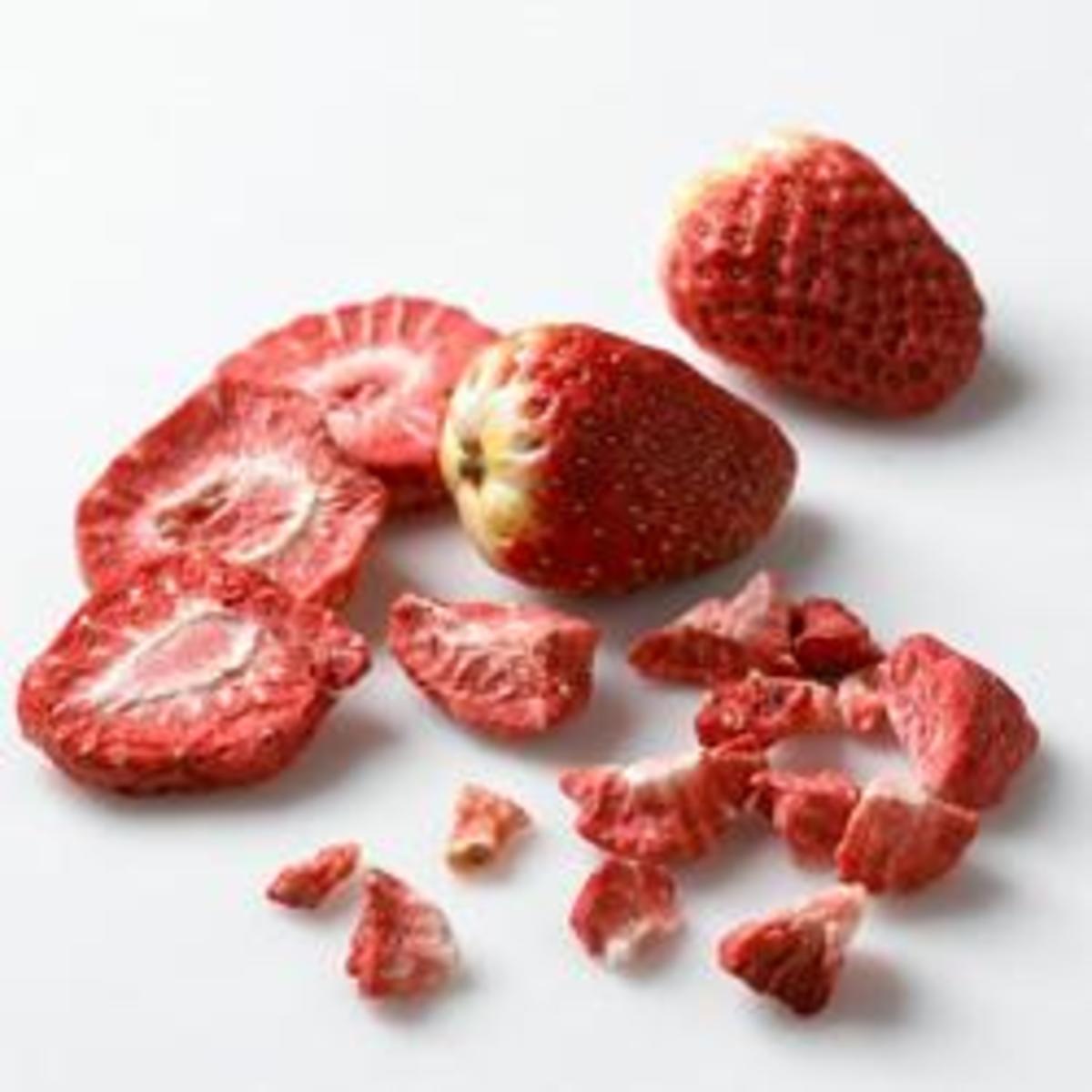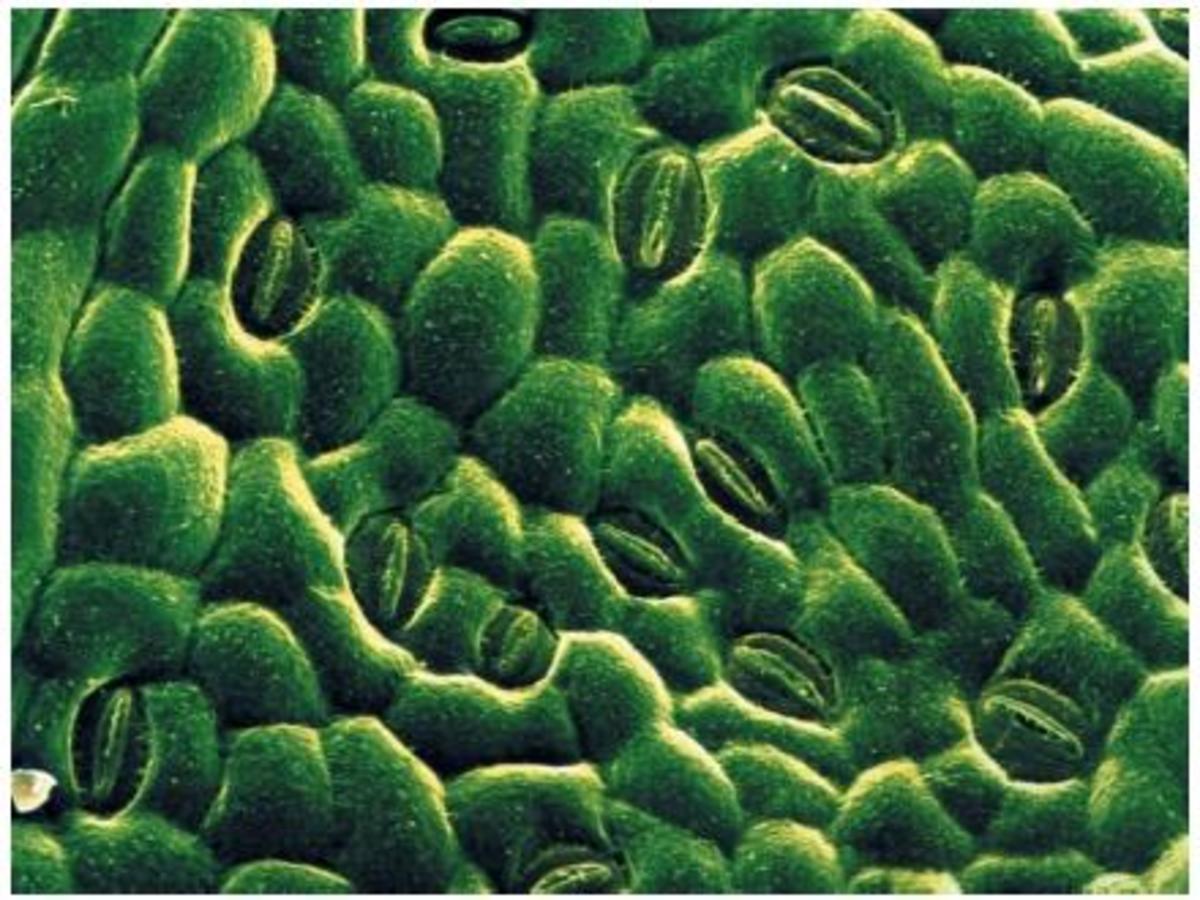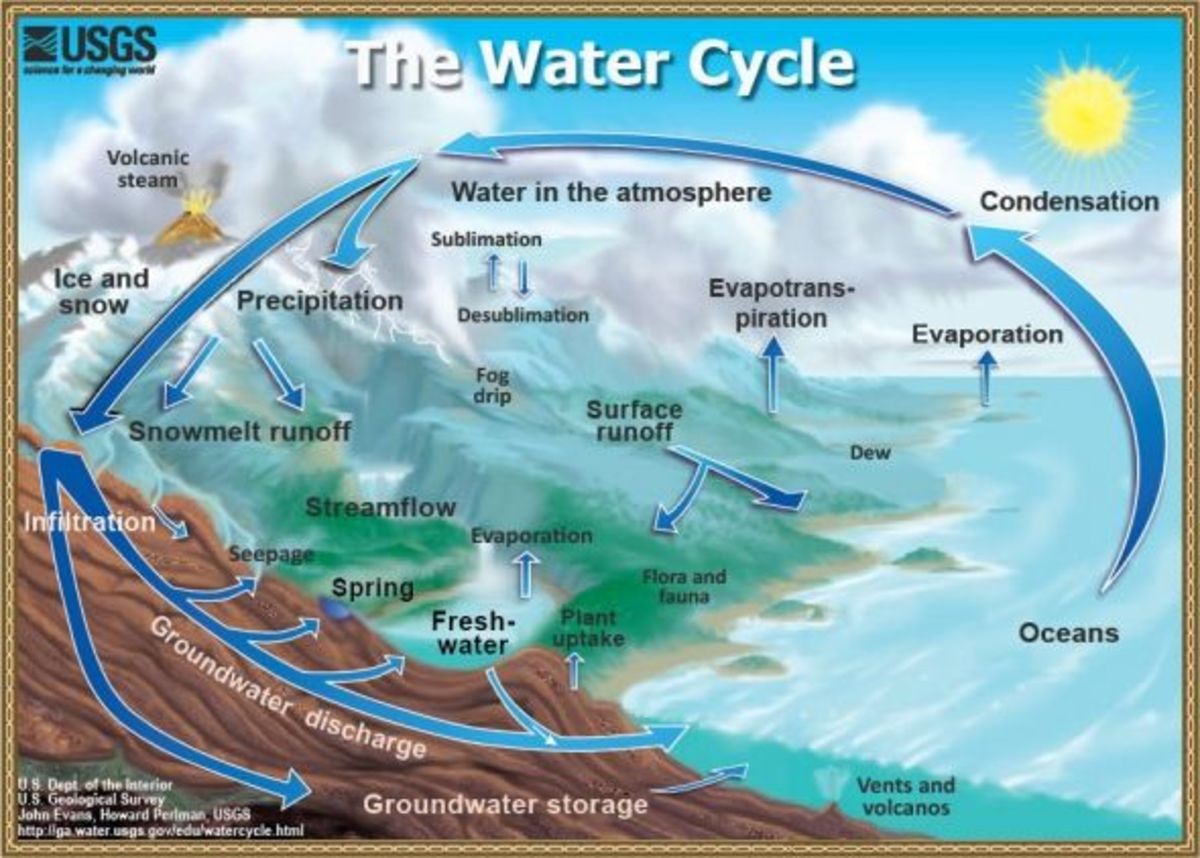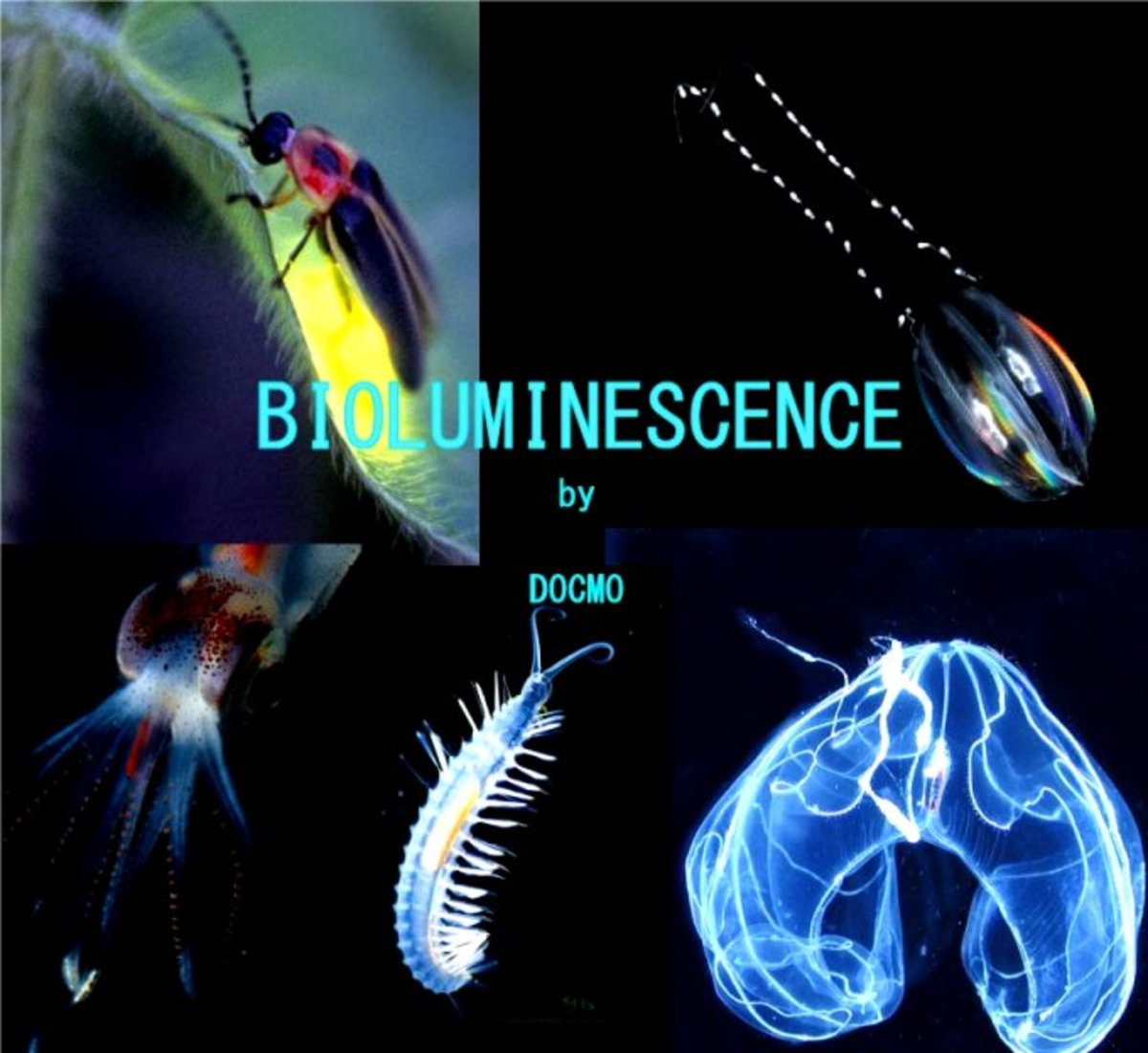OCR AS Biology - Revision - Part 2 - More Plants!
Measuring Rate Of Transpiration
A potometer is a piece of equipment used to estimate the rate of water loss in a plant.
It measures the amount of water taken up by a plant shoot, which isn't a completely accurate measure of transpiration because not all of water is lost through transpiration (99%).
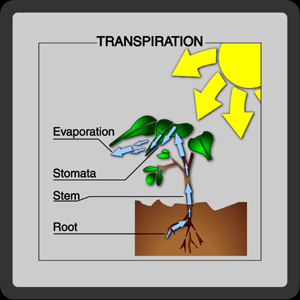
Transpiration
Definition of Transpiration:
The loss of water by evaporation, from the upper parts of a plant - particularly the leaves.
How does it happen?
Water enters the mesophyll cells from the xylem by osmosis.
The water evaporates into water vapour from the surface of the mesophyll cells.
The mesophyll cells have large air spaces between them and when water vapour collects in these spaces the water vapour potential becomes higher in the cell than outside.
This water vapour potential gradient causes the water vapour to diffuse out of the leaf through the open stomata.
The Transpiration Stream:
As the water leaves the leaf in the form of water vapour, it must be replaced by new water coming up the stem through the xylem and from the roots. The movement of water up the stem is called the transpiration stream.
Why is the transpiration stream important?
- The leaves need a constant supply of water for photosynthesis.
- The water allows cells to grow and elongate.
- The water also keeps the plant cells turgid.
- The water carries minerals up the plant.
- Transpiration (evaporation of the water) keeps the plant cool.
Things that affect the rate of transpiration in a plant are:
- The number of leaves that the plant has - The more leaves there are, the bigger the surface area and thus the more water is lost during transpiration.
- The size, amount and the position of the stomata on the leaf - The more stomata there are the more water is lost, however if the stomata are on the lower surface of the leaf then less water is lost.
- Light - In sunlight the stomata open to allow gas exchange for photosynthesis to happen and therefore more water vapour will be lost.
- Temperature - A higher temperature will cause a greater water loss because it will increase the evaporation rate from the surface of the leaf so the water vapour potential in the mesophyll cells will be increased and the water vapour potential outside the leaf would be decreased, therefore more water will diffuse out of the leaf. Also, the water molecules will have more kinetic energy and move out of the stomata faster.
- Humidity - Higher humidity will decrease the transpiration rate because the difference in water vapour potential gradient between the mesophyll cells and outside the leaf will be smaller.
- Wind - If it is very windy then water that has been diffused out of the leaf will be carried away quickly and the water vapour potential outside the leaf will remain low and the gradient between the mesophyll cells and the outside of the leaf will be high.

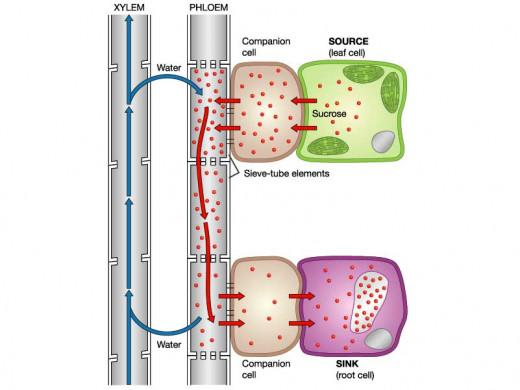
Translocation
Definition of Translocation:
The transport of assimilates (sugars and other chemicals that are made by the plant's cells) through the phloem.
Sugars are mostly transported in the form of sucrose. The part of the plant that releases the sucrose into the phloem is called the source, and the part of the phloem that removes the sucrose is called the sink.
The companion cells of the phloem have lots of ATP producing mitochondria. The ATP in the companion cells is used to actively transport hydrogen ions out of their cytoplasm and into the surrounding tissue. This creates a diffusion gradient.
Because there is now a higher concentration of hydrogen ions outside the cytoplasm they hydrogen ions diffuse back into the cell's cytoplasm, through special cotransporter proteins, down a concentration gradient.
The cotransporter proteins allow the hydrogen ions to bring back sucrose molecules with them back into the companion cells. This means the concentration of sucrose molecules is higher in the companion cells than in the phloem and thus another diffusion gradient is created.
The sucrose molecules then diffuse into the phloem's sieve tube elements, through the plasmodesmata.

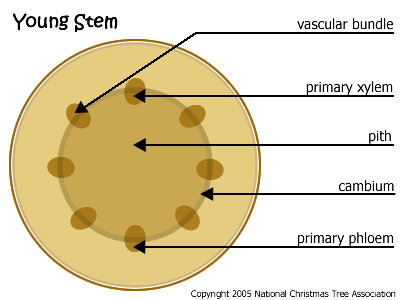
How does sucrose move across the Phloem?
- Sucrose actively transports into the sieve tube element.
- The water potential in the sieve tube decreases.
- Water then flows into the sieve tube element by osmosis (down a water potential gradient).
- The hydrostatic pressure (pressure created by a fluid pressing against the side of a container, or in this case the phloem) in the sieve tube elements increases.
- Water moves down the sieve tube from a higher hydrostatic pressure (at thesource) to a low hydrostatic pressure (at the sink).
- Sucrose is then removed from the sieve tube by the surrounding cells (that either need it to convert into starch or use it in respiration).
- The sucrose concentration in these cells then decrease.
- The sucrose molecules then continue to move to the cells surrounding the phloem via diffusion.
- The water potential in the sieve tube elements then increases and water molecules move into the the surrounding cells (which have a lower water potential) by osmosis.
- This reduces the hydrostatic pressure at the sink in the phloem.
- Water entering the phloem at the sink and then moving down a hydrostatic pressure gradient and then leaving at the sink creates a flow of water,
- This water carries sucrose and other chemicals made by the plant cells. This is called mass flow.
- Depending on what part of the plant needs sugar or other assimilates depends on whether the mass flow moves up or down the plant.
Where are the sources and sinks located?
The leaf of a plant is a source. During photosynthesis the leaf makes sugars that are then converted into sucrose and actively transported into the phloem.
However this only happens when the leaves are fully grown, whilst the leaves are still growing they need energy in the form of sucrose. Sucrose will be supplied to the leaf from another source and the leaves will act as a sink.
Roots are also a source. The carbohydrates that the roots store are transported into the phloem. This process normally occurs in the springtime when other parts of the plants need the carbohydrates to use as energy so that they can grow.
However during the summer the roots store sugars as starch. This shows that the roots can act as both a sink and a source.

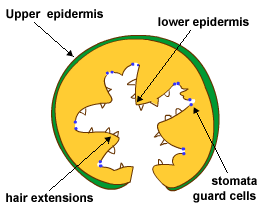
Xerophytes
Definition of a Xerophyte:
A plant that lives in very dry conditions that is adapted to reduce water loss.
Transpiration is unavoidable. Around 99% of water that the plant takes up gets lost due to transpiration. During the day plants take up carbon dioxide to use in photosynthesis and remove oxygen (the by-product of photosynthesis) and to do this the stomata must be open. The open stomata provide an easy route for the water to be lost from the plant.
However, Xerophytes are adapted in the following ways in order to reduce the amount of water they lose:
- They have smaller leaves.
- They have densely packed mesophyll cells which reduces the cell surface area.
- They have a waxy cuticle on the leaves which reduces evaporation.
- They close their stomata when there is little water available.
- They may have hairs on their leaves which traps a layer of air which can become saturated with moisture and increase the water vapour potential outside the cell. This in turn decreases the amount of water vapour that is diffused out of the mesophyll cells.
- The leaves have pits in which the stomata are at the base. This, much like the hairs, helps trap air which will become saturated with moisture and reduce the water vapour potential gradient between the mesophyll cells and outside the leafs.
- Some plants roll up their leaves when water availability is low, again they do this to trap air.
- Some plants have a high salt concentration on the cells of the leaves. This reduces the water potential in the cells and the amount of water that is evaporated reduces.

